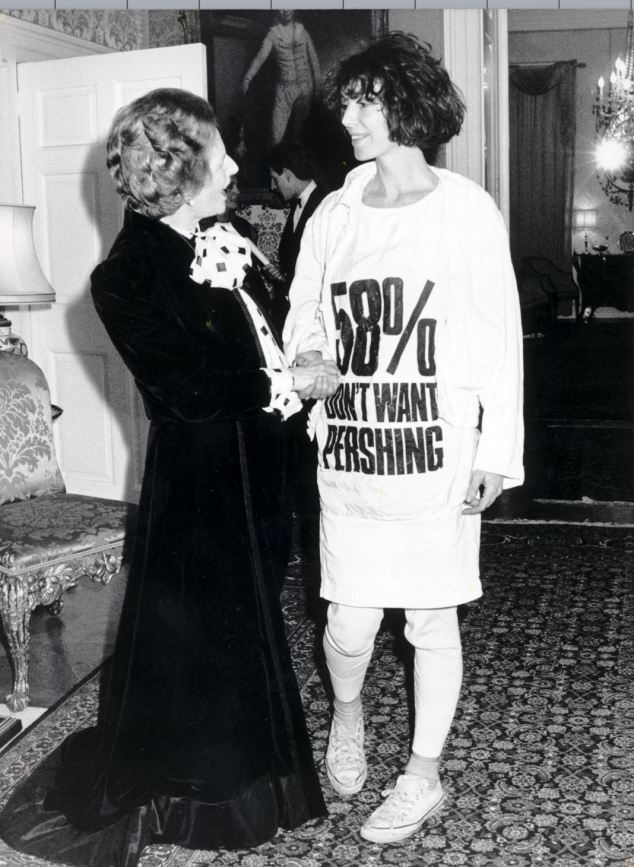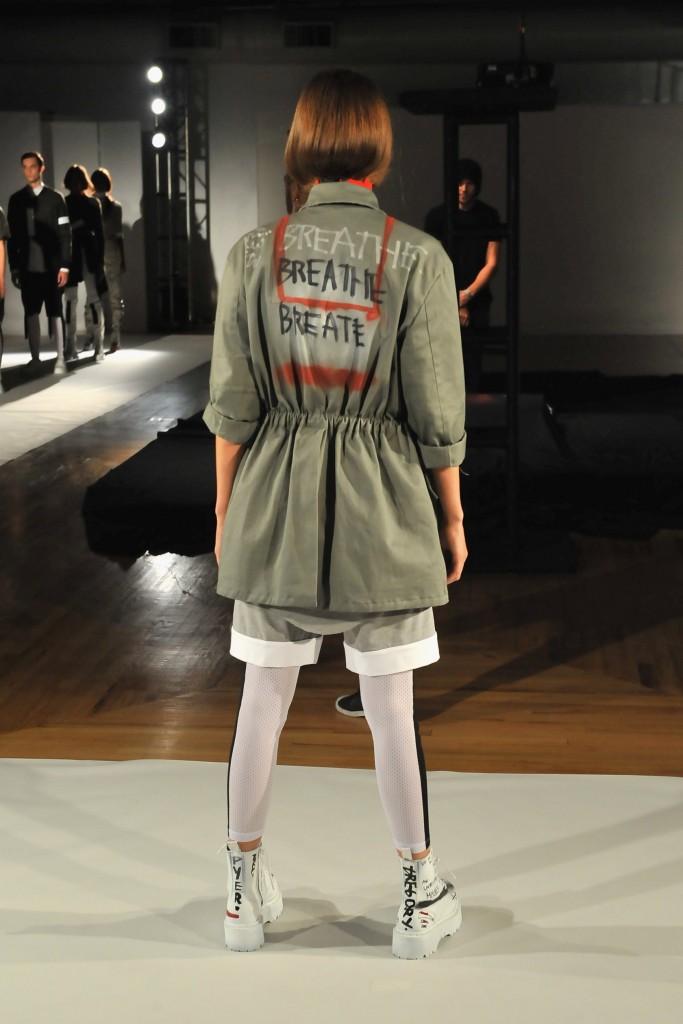
ON THE TUESDAY BEFORE New York Fashion Week, two months before the U.S. presidential election, American designers demonstrated their political zeal with swag. The ‘Made For History’ collection, which debuted at a runway fundraiser, included a bandana by Thakoon, a pouch by Brett Heyman and T-shirts by Marc Jacobs, Joseph Altuzarra and Tory Burch. These favoured, predictably, Hillary Clinton. ‘Unlike the Republican candidate’s unspeakably hideous ties, our collection is made in America by union workers,’ announced host Anna Wintour.1 Two more Clinton fundraisers would be held before the week wrapped. ‘I attended all these events because being a Democrat is always fashionable,’ wrote the socialite journalist Derek Blasberg.2
Before there was Clinton swag, there was Obama swag. Before there was Obama swag, there was Kerry swag. (Donald Trump has swag, but no designer names are attached.) That the fashion industry leans to the left is no surprise considering that seventy per cent of people currently favour Clinton in New York City, where the U.S. fashion industry is also based.3 All the same, it’s worth asking: if being a Democrat is always fashionable, whom are these items really trying to convince? Do we purchase Diane von Furstenberg’s Hillary Clinton T-shirt to show solidarity, or to build our personal brands? Do designers create them because they will change hearts and minds – or to reassure themselves that their industry has a role to play in their nation’s critical decisions?
For an industry whose existence hinges on newness and excitement, an election year is a threat. Hemlines are not important when millions might lose healthcare coverage. Front row quotes appear meaningless when the future of foreign policy is being debated. Collections like ‘Made For History’ are meant to encourage political engagement among consumers – but they also assert the fashion industry’s relevancy at a time when it is in jeopardy.
Fashion is especially vulnerable to accusations of frivolity during moments of social turmoil. Consider Marc Jacobs’ recent use of dreadlocks on a cast of predominantly white models, the farthest-reaching political message of the most recent New York Fashion Week (and, ironically, per Jacobs, an accidental one). The show ignited outrage over cultural appropriation, but pundits also criticised the backlash as a distraction. ‘Don’t Rage Over Dreadlocks While African Americans Are Dying in the Streets,’ read the headline of an op-ed by Columbia University professor John McWhorter. ‘Republicans are trying to deny black people the vote nationwide… A War on Drugs has destroyed black communities left and right… Amidst all of that – hair????????’4
The industry has not historically positioned itself as an authority on serious political matters. Like many for-profit enterprises, fashion labels benefit from neutrality – Oscar de la Renta for example famously dressed First Ladies from Kennedy to Reagan to Clinton. Similarly, retailers discourage controversy. Katharine Hamnett, a British designer known for T-shirts with slogans like ‘SAVE THE WORLD’ and ‘WORLDWIDE NUCLEAR BAN,’ recalls trying to sell her creations in the early 1980s: ‘American buyers were rushing into my showroom, willing to spend their money. They took one look at the T-shirts, got a horrified look in their eyes, spun around on their heel and left.’5 Similarly, New York label Pyer Moss’ spring/summer 2016 collection, which featured slogans from the Black Lives Matter movement, reportedly cost the brand $120,000 worth of business, according to the designer,6 though the collection was covered by dozens of media outlets and garnered praise from celebrities including Usher and Erykah Badu.

Sartorial Sloganeering has a Catch 22: when a message is radical enough to provoke, its garment is incompatible with commercial distribution. When a garment is a commercial success, its message fades. Hamnett’s T-shirts, while initially controversial, eventually became popular among celebrities and musicians, and were knocked off by everyone from other designers to the pro-life movement, who appropriated her ‘CHOOSE LIFE’ message, initially created to discourage drug abuse and suicide, to oppose abortion.
It’s telling that, in creating a political fashion statement, the right has borrowed from the left. Though conservatives have more recently developed aesthetic languages of their own – consider the gore of anti-abortion billboards – movements like Black Power, Women’s Liberation and anti-Vietnam war protests were some of the first to harness self-presentation to communicate via mass media. In America, the aesthetics of protest are historically linked to progressive causes.
This does not mean that the values Donald Trump represents are absent from contemporary fashion design. Clothing that promotes gender conformity, and which bolsters existing power structures by glamourising wealth and whiteness, is so ubiquitous that you sometimes forget about it until it bumps awkwardly against a new attempt at ‘wokeness.’ This is as true internationally as it is in the U.S. Consider Chanel’s spring/summer 2015 show, for which Karl Lagerfeld chose the theme of a feminist protest. Models brandished quilted-CC loudspeakers and signs inscribed with a mix of second-wave mantras (‘History is Herstory’), cute one-liners (‘Make fashion not war’) and gibberish (‘Tweed is better than Tweet’). A brooch from the collection featured an image of the house’s founder, Coco Chanel, with the slogan ‘Feministe mais Feminine.’ The show omitted Chanel’s other political history as a Nazi sympathiser, as well as Lagerfeld’s 2009 assertion the house’s founder ‘was never ugly enough’ to be a feminist.7
Chanel’s brand was recently estimated to be worth $7.2 billion,8 yet it positions itself not as the product of corporate market research, but of individual conviction and creative genius. With the number of seasons, collections and fashion weeks increasing, political statements benefit brands by attracting media coverage. But they also position fashion as more art than industry, all the better to smooth friction between progressive values and capitalist profit motive.
Might clothing actually ‘SAVE THE WORLD’? ‘T-shirts are great, but they don’t change anything, really,’ Hamnett said last year. ‘Unless you take constructive action in other areas of your life, just wearing a T-shirt actually isn’t going to do anything.’9
Alice Hines is a writer living in New York City.
https://www.theguardian.com/fashion/2016/sep/07/hillary-clinton-fashion-show-fundraiser-anna-wintour ↩
http://www.vanityfair.com/style/2016/09/nyfw-2016-hillary-clinton#19 ↩
http://www.timesunion.com/local/article/Poll-Clinton-still-buries-Trump-in-New-York-9235547.php ↩
http://time.com/4497956/marc-jacobs-dreadlocks-outrage/ ↩
http://www.stylemag.net/2008/08/11/cotton-courage-katharine-hamnett-2/http://www.stylemag.net/2008/08/11/cotton-courage-katharine-hamnett-2/ ↩
http://www.vice.com/read/how-police-shootings-and-personal-loss-have-inspired-the-fashion-of-pyer-moss-456 ↩
http://www.harpersbazaar.com/fashion/trends/a421/coco-chanel-karl-lagerfeld-0909/ ↩
http://www.forbes.com/companies/chanel/ ↩
https://i-d.vice.com/en_us/article/why-fashions-eco-warrior-katharine-hamnett-is-kanyes-main-muse ↩